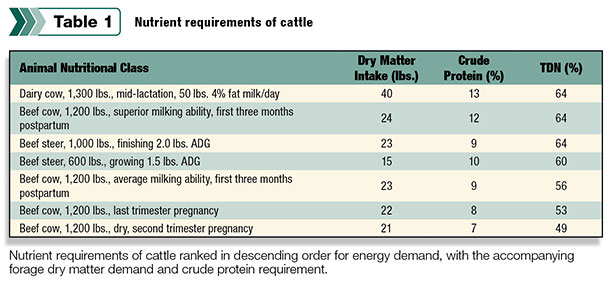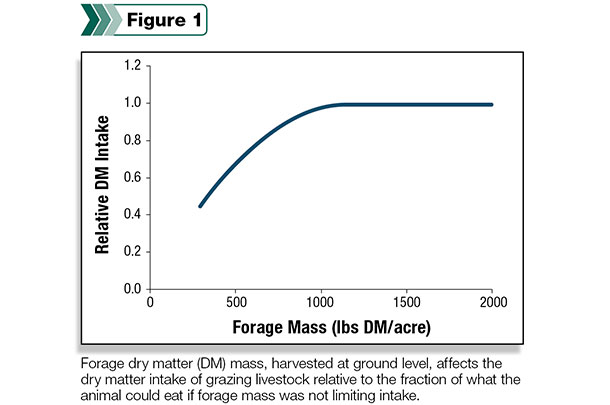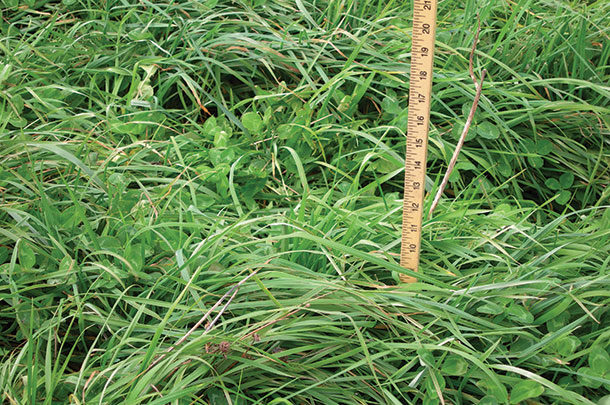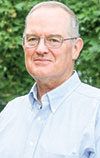Forage quality needs to meet the animal’s nutritional requirement (Table 1) in order to maintain animal performance.
Cattle gain more weight and produce more milk when fed high-quality versus low-quality forage. Five fundamental principles determine forage quality:
V = Vegetative growth stage
A = Availability
L = Legume content of the forage
U = Utilization of the stand
E = Environment in which the forage is grown

Vegetative growth stage
As forage matures, quality decreases. Pastures should be in a vegetative growth stage if forage quality is to be high. For hay, yield is a major factor in reducing the cost per ton of hay harvested. Therefore, delay mowing hay until the grass is in the late boot to early head-growth stage to optimize yield and quality.
Availability of pasture
If an adequate amount of pasture is not provided, cattle cannot consume maximum levels of forage, even if the quality is high. When pasture forage mass falls below 1,200 pounds dry matter (DM) per acre, forage availability limits forage DM intake (Figure 1).

When forage mass is greater than 1,200 pounds DM per acre, pasture intake will be at a maximum determined by forage quality, forage utilization, animal size and condition, and milk production if lactating. Maximum forage intake is also affected by forage species and rate and characteristics of fed supplements.
Forage mass can be estimated in a rotationally grazed pasture from canopy ruler height. A mixed orchardgrass-bluegrass-clover stand 8 to 10 inches tall has a standing forage mass of about 3,000 pounds DM per acre, cut to ground level, or about 300 pounds per inch of height.
A dense tall fescue stand at the same height will have a forage mass pushing 5,000 pounds DM per acre. Hay aftermath and other thin stands will have less forage mass per unit height than will these dense pastures.
Forage growth rate varies over the year. In the Northeast, spring growth rate peaks at about 90 pounds DM per acre per day in early June, decreases to 30 pounds DM per acre per day during the summer, tailing off to near zero by mid-October.
To balance animal forage demand with forage production, there should be planned buffers in the system. If not, buffers will occur, but they may not be what is wanted. Buffers include:
- Grazing aftermath growth in hayfields
- Growing perennial or annual warm-season grasses as supplemental feed
- Selling yearlings mid-summer or calves in the fall to reduce forage demand
- Stockpiling forage for fall grazing
- Wasting spring forage (understocking)
- Allowing the loss of body condition on cattle during the summer (overstocking)
- Feeding stored or purchased supplemental feeds
For example, a 1,200-pound cow consuming forage at 2.5 percent of her bodyweight will eat 30 pounds DM per day. When the pasture growth rate is 60 pounds DM per acre per day in June, this cow will need 0.5 acres of pasture.
Later in the summer, when the growth rate is 30 pounds DM per acre per day, she will need 1 acre of pasture. If half of the acreage is hayed in May or June, regrowth will be available in July and August to provide more acres for grazing when the forage growth rate is lower.
Livestock operation profitability is highly dependent on how buffers are managed to reduce feed cost over the year and meet the animals’ nutritional requirements to optimize animal performance.
Legume content of forage
Legumes in pasture or hay have a positive effect on animal performance. Grass-legume pastures allow cattle to consume more forage than do straight grass pastures.
For growing steers, 30 percent legumes in a pasture provides an additional 0.25 to 0.5 pounds gain per head per day over the grass fertilized with nitrogen. For dairy cows, legumes sustain an additional 8 pounds milk per head per day at the same rate of grain feeding.
Response to legumes occurs because legumes have less fiber than grasses (Table 2), allowing livestock to eat more DM when legumes are in the stand.

This results in fewer animal unit grazing days per acre on a grass-legume versus grass pasture at the same forage yield. The lower-fiber legume forage is also digested more efficiently, providing more net energy than does a higher-fiber grass (Table 2).
Legumes replace the need for nitrogen fertilizer. In Virginia, orchardgrass-clover pastures provided the same yearling steer gain per acre as orchardgrass pastures fertilized with 200 pounds nitrogen per acre per year. This savings amounts to $100 per acre per year when fertilizer costs $0.50 per pound of nitrogen.
Legumes can be added to pastures by no-till or frost seedings. Prior to seeding, make sure the soil pH is at or above 6.0 for clovers, or 6.5 if alfalfa is to be seeded. Ensure that soil test levels for phosphorus, potassium, calcium and magnesium are in the high range to optimize clover nutrition.
Legumes respond to relatively close grazing for short periods of time to reduce grass competition during regrowth. Then adequate rest between grazing events is needed to restore carbohydrate reserves in the legume’s taproot and stolons. Depending on the weather, the rest interval needed by legumes is 4 to 6 weeks or until the legumes come into early flower.
Utilization of the stand
Pasture utilization determines how selective livestock can be when they graze a pasture. Selective grazing is the ability of animals to eat forage of higher quality than the average forage in the pasture. When adequate pasture forage is provided, cattle “eat the best and leave the rest.”
The quality of forage consumed by grazing animals is dependent on the quality of forage when they go into the pasture and the degree of pasture utilization at the end of grazing (Table 3). As forage quality increases, the quality of the forage consumed increases. As the fraction of pasture utilized increases, the quality of the forage consumed decreases, since animals have less ability to selectively graze.

It is tempting to think that if we have low-quality pasture, we can solve the problem by providing enough acres of pasture to allow selective grazing. This has limited application. Providing high-quality pasture is the practical way of providing high-quality forage to the grazing animal. Then if animals have a high nutritional requirement, we can allow selective grazing (low to moderate utilization) to ensure high nutrient intake.
However, if the animals have a low nutrient requirement, we can use high utilization rates to limit selective grazing and provide a lower nutrient intake in line with animals’ needs. For example, when backgrounding weaned calves, allow them to utilize only 40 percent of the forage to enable selective grazing and high nutrient intake. After the calves are shipped, dry cows can clean up the pasture residue and put on body condition for the winter.
Environment in which the forage is grown
Environmental conditions affect forage quality. Cool weather in spring and fall increases total digestible nutrients and crude protein, and decreases neutral detergent fiber content (Table 2). Warm summer weather decreases total digestible nutrients and crude protein, and increases neutral detergent fiber content.
When pasture is too rich in early spring or fall, hay may be needed to improve rumen health, reduce passage rate and increase the nutrients digested from this succulent forage. Summer pasture can be improved by ensuring that pastures have a good legume content to maintain protein and forage with lower fiber content.
To obtain good animal performance, the manager needs to be mindful that value is found in pastures that are vegetative, available, have legume content of 25 percent to 30 percent or more, are utilized to the proper extent for the livestock grazing the pasture and are managed in tune with environmental conditions. FG
PHOTO: Forage mass can be estimated with a canopy ruler. This mixed orchardgrass-bluegrass-clover stand at 8 to 10-inches tall yields about 300 pounds of forage per inch of height. Photo courtesy of Ed Rayburn.

-
Edward B. Rayburn
- Extension Specialist
- West Virginia University
- Email Edward B. Rayburn











